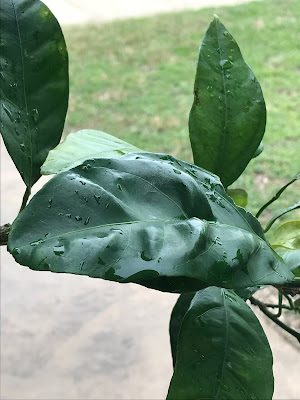Thursday, October 22, 2020
No solo dining for this crab spider
Major milestones
Monday, October 12, 2020
Notes to myself
That tall, branchy wildflower with white flowers that I saw blooming this month alongside eryngo (Eryngium leavenworthii) was false gaura (Stenosiphon linifolius).
I've seen it blooming in years past alongside U.S. 290 west of Dripping Springs. I ALWAYS forget what it is. So I've gone nearly crazy, trying to figure out what it was when I saw it on our road trip traveling north along U.S. 281. We were going too fast to get photos. So this is a note to myself in case I forget again. It's a wildflower that gets VERY little press.
Saturday, October 10, 2020
Six times!
Yes. My cenizo friend across the street is blooming yet again. For the sixth time! I took the flower photos Thursday morning. Sure enough, Friday morning brought gray clouds and some slight drizzle, enough to wet the outdoor furniture and plants. The humidity was high, too, like 99 percent (I got a screen shot of 96 percent a bit later). No huge rains in sight, but you never know. I think yesterday morning's damp conditions count. So make that six times in a row!
Friday, October 9, 2020
Birdy surprises on our trip
This past week, we traveled to northwest Arkansas for our periodic Eureka Springs fix. Along the way, we stopped for gas in Gainesville, Texas. I was quite surprised when I looked out my car window and saw this mostly WHITE great-tailed grackle. He/she wandered around a bit on the parking lot, then took off with a big flock of other BLACK grackles. Wow!
UPDATE: Birder Joseph Neal from Arkansas informed me that we saw a leucistic grackle. "Leucistic" means a partial loss of pigmentation. Here's an explanation of the difference between leucistic and albinism.
On our last night in Eureka Springs, we walked downtown and sat on a bench in Basin Park. The sun had just about set. Overhead, I heard chimney swifts. I looked up. There were dozens and dozens of them flying and swooping over the Basin Spring Bath House. I got up from the bench and walked across Spring Street for a better look. Then I kept going. James followed. I walked across the pedestrian bridge that goes over N. Main Street, then down the bath house's stairs. We ended up in the big parking lot, where we watched in amazement and took videos (see mine below) while the swifts soared in circles and, one by one, dove into the chimney.
Finally, one lone swift flew around by itself. Was it maybe a bat, we wondered. Then a second swift showed up, and together they disappeared into the chimney. Such a cool surprise to witness! I'm thinking the bath house may be serving as a communal roost for the swifts, who overwinter in the upper Amazon basin of Peru, Ecuador, Chile and Brazil. Awesome!










